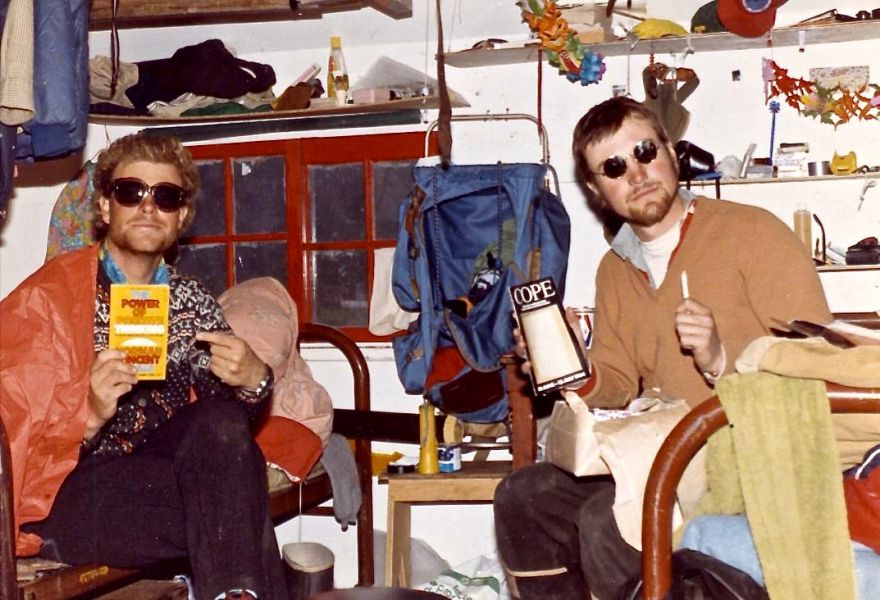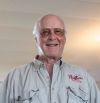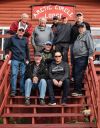Beginnings
![]() Written by
Harold
Written by
Harold
- Published in The "D" Tales
- Read 2600 times
- font size decrease font size increase font size
First of all I should make it very clear that I’m writing this from memory. And my memory is considerably shorter than it used to be.
I haven’t kept in touch with many of the guides, so I can’t check my stories, so apologies if it’s all-wrong!
I tend to remember the parts I like, even if I had to make a few bits and pieces up to fill in the gaps.
I grew up in West Vancouver. My dad was a lawyer, and then became a judge.
He had a Piper Comanche, and often traded with a friend for his Cessna on floats. We fished in quite a few places around BC, always for trout. I don’t think I’ve ever caught a salmon and I don’t like to eat them, either!
Heck, I wasn’t that fond of any fish when I was young, and I don’t think we ever had fish on our dinner table. Strange world. But boy have I come around!
These days I own a TV commercial service production company based out of Vancouver. We help foreign companies produce their commercials all over Canada, but I haven’t made it back to the Bear yet.
In the late ‘70s I was in and out of various universities, backpacking around Europe, and planting trees in northern Ontario.
My best friend from high school, Murray Dee, somehow got a job as a guide on Great Bear in 1980 when we were both around 20 years old. Murray persuaded the lodge owners to hire me the next year. I was scared out of my mind. I had a bare minimum of fishing skills, and Great Bear was a trophy lake!
From what I heard guests were paying over $2,000 for 7 days of fishing.
I remember holding the boat against the dock as my first guest, the owner of the Mr. Submarine franchise in Ontario I believe, stepped in and he asked: “How long have you been guiding, Dave?”
I said, “about as long as you’ve been in the boat, sir!”
That didn’t go over well.
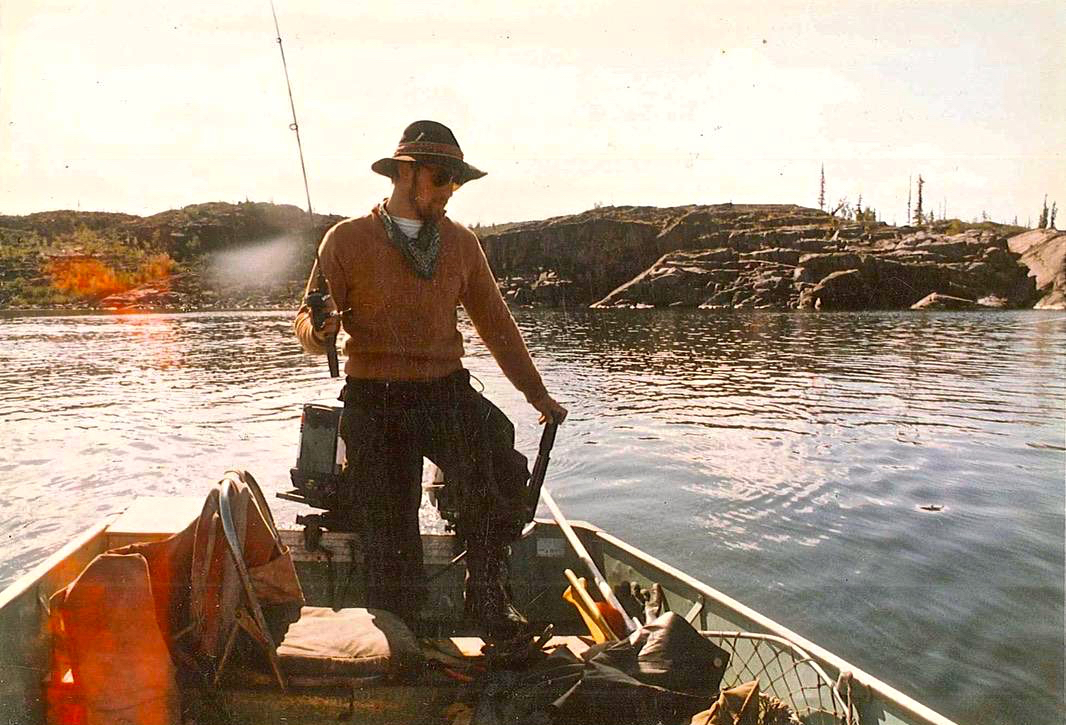
Many of the guides that year were university students from Ontario. There were also two First Nations guys, a couple full-on red necks from somewhere back in the Canadian bush, and a couple old timers.
The most senior guide was First Nations, and he always had on one of those fringed moose skin coats. The other First Nations guy wore a polyester shirt with half the buttons missing, and polyester pants with a broken fly.
When we arrived in late June the temperatures were all over the place. I think the 2nd or 3rd day in we heard Great Bear had the highest temperatures in Canada! But then we’d get in a boat and freeze our butts off!
In the first few weeks when I went out on the water I would wear the following: cotton long johns, Stanfield wool long underwear, two wool shirts, wool pants, a wool sweater, some sort of scarf, a full set of Black Diamond rubber rain gear, two pairs of wool socks, rubber boots, wool gloves, rubber gloves over the wool gloves, and a toque under a sou’wester.
It was frickin cold!
I’d done a fair bit of camping, hiking and bushwhacking, so I wasn’t exactly a pampered cat from the city. But seriously, the First Nations fellow in nothing but polyester? That’s all he wore on the lake! How the heck he didn’t freeze I’ll never understand.
Someone told me he once cut the palm of his hand open while filleting a lunch fish three hours from the lodge. He sewed it up with 4 - pound test and a fish - hook, and then went back to cooking and guiding without saying a word.
Wow. Tough guy.
Mavis and Ernie were not totally oblivious to my inexperience and made sure that when I went out for the first few weeks they always sent Wally with me. Wally was one of the vets. He was skinny, gnarly, a growl in his voice and focused like a Great White Shark on catching fish.
Having Wally there made the guests feel a lot better - or at least too afraid of him to ask any questions! I’d ask him nonchalantly, what lure he was using, and he’d shout back “Lucky Strike” or “T60,” and I’d tell the guests in my boat that I was in full agreement with Wally’s decision.
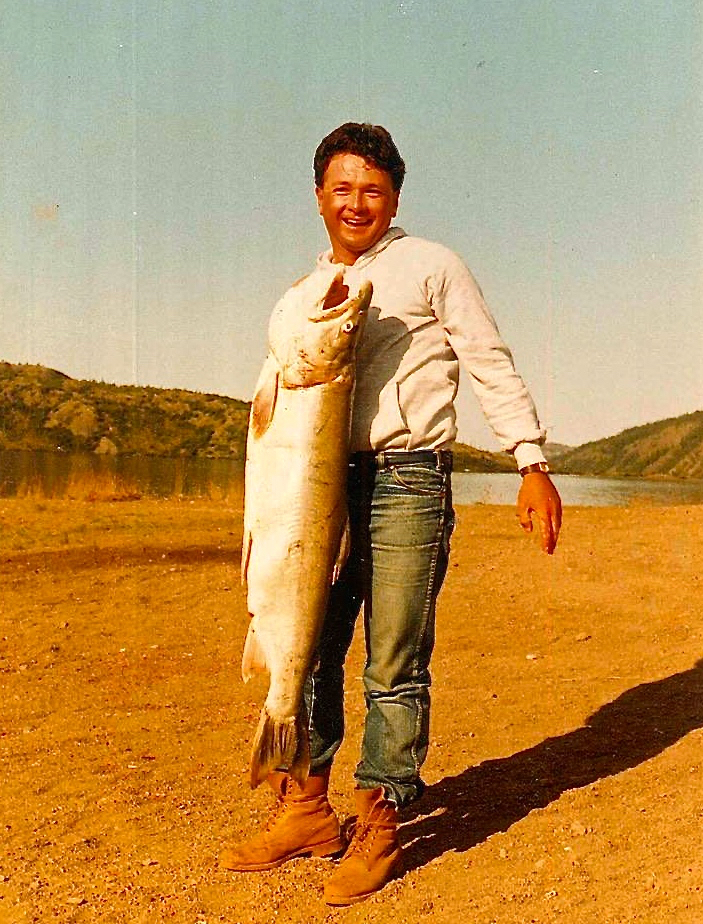
It all worked out fine. I was pretty intimidated by Wally, but we eventually became friends when he discovered that Murray and I had brought up a little stash.
I was told that the year before Murray was first hired, most of the guides were First Nations, but before I get into the how’s and why’s of the changeover, I should say something about the lodge alcohol policy.
Beer was something like $3.50 a can and you were limited to two cans a night. I’m pretty sure $3.50 was my hourly wage so, the two can limit wasn’t really a hardship. The guests however, could buy whatever they wanted from the lodge, and most would buy a bottle of rum or whisky for the boat.
After a couple of nice big fish they’d sometimes give a full bottle to the guide.
I should also mention the situation with women at the lodge. I think there were three or four plus Mavis.
The girls were all there to make beds and serve meals. But after a month or two in the middle of nowhere, relations between a guide and a gal might start to warm up. So, legend has it, to prevent friction, Ernie had the chef put saltpeter in all the guides’ food, but somehow this didn’t stay a secret.
One day, towards the end of the season, most of the guides had a bottle, and decided to have a party. Halfway into the fun they all went down to the kitchen and demanded to see the saltpeter. They were drunk, angry, and some may have had their filet knives. They marched Ernie and a can of saltpetre into the woods and watched as Ernie dumped it into the ground and spread it around so it wouldn’t be going into anyone’s beef stew or blueberry pie ever again. Then they went back to finishing the rest of their bottles.
The next morning a Twin Otter taxied up to the dock. Ernie appeared at the guide shack door with a shotgun and escorted all the guides to the plane and off to Yellowknife. At least that’s what I was told. After that Ernie mostly hired out of the universities.
To get to Branson’s you first arrive in Edmonton and then, in my time, you took an ancient 2 engine passenger plane (some kind of Convair?) for about 4 hours to the old landing strip built for the mine at Port Radium, which was located about 20 miles north of the lodge. Then, especially if you were a guest, you got in one of the two or three float planes (Cessna’s and a Beaver) and flew the 5 minutes to the lodge in Cameron Bay.
The first time in all the guides were taken by school bus down past the old mine site (a lot of it still standing when I was there), and then we got into some sort of a cabin cruiser and that took you to the lodge.
Port Radium, for those that don’t know, was formerly a radium mine and then, during World War II, a uranium mine. Some of the uranium from Port Radium went into the first nuclear bombs that were tested in the New Mexico desert and then dropped on Japan.
Cameron Bay, where the lodge was built (it’s since been mostly bulldozed) was the town that sprang up to support the mine. There was a Hudson Bay store, an RCMP station, a wireless station, hotels, restaurants, and other housing.
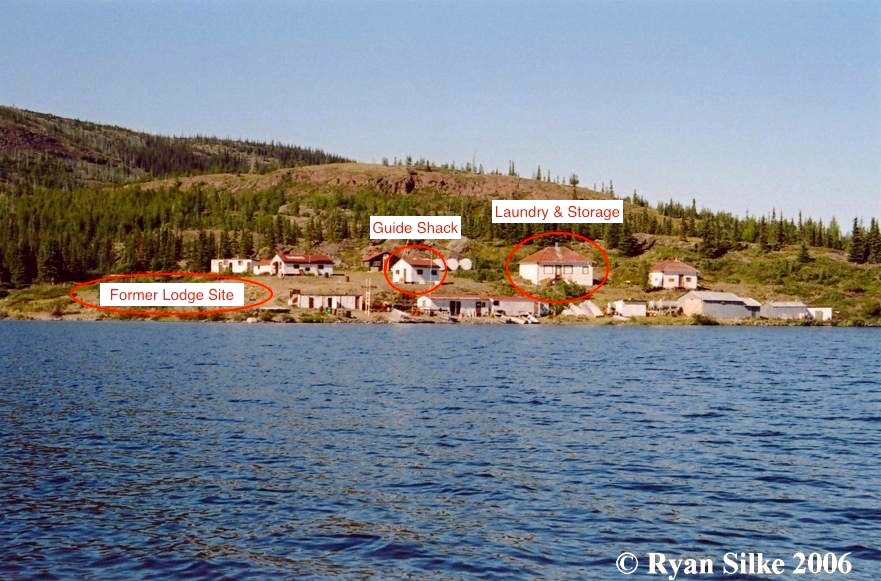
When I was at Branson’s the only buildings still standing was the RCMP log building, and the Hudson Bay store. The RCMP station was used as one of the guide shacks, and the old store was general storage and laundry for the lodge. I have one last story to finish off this piece.
On Saturday all the guests flew back to Edmonton and home, and on the incoming flight, the next batch of guests, including all of the groceries for the following week, would arrive. A couple of us, who were assigned to unload the groceries and luggage, figured out that amongst those supplies was also the week’s beer!
There was so much of it we figured a little flat wouldn’t go missing, so while unloading that day I quietly hid a case in a new washing machine that had also been shipped in. We transported all the groks and such by bus and cruiser to the lodge, and then I personally made sure the washing machine made it safely to its new home.
Every day 20 or so boats and guides with 40 about guests would head out from the lodge for a days fishing. We’d spread out all over, some going south towards Action Alley, some north around the islands, and some fishing just around Cameron Bay.
I think the biggest fish I didn’t catch was hooked just in front of the lodge, but after a - 3-hour fight, we lost it! But at least I saw it. Made me want to jump in with an axe it was so big!).
We’d all make sure to catch a lunch fish (or get spammed!) and sometimes we’d bring fish back to the lodge where we’d gut and clean them for the guest’s dinner.
Each night a couple of guides would take the gut - bucket up the bay a ways and to dump away from the lodge, and I decided this mission might be a perfect mid-week reason for a little stolen bear swilling.
One of the other guides was studying wolves, and there was a pack living near the lodge. This night we took the guts and hung them on some of the smaller tress around the little bay. My pal started howling and I started drinking and we waited.
After about a half hour the alpha male showed up, checked us out, checked out the fish guts, and howled for the rest of the pack. The two of us sat there drinking beer and watching the wolves pull fish bits out of the bush. Great fun under the midnight sun!
Unfortunately I wasn’t attuned to the environment, and I needed to hide the evidence so we sunk all the cans.
Once the beer was gone all that was left was the cardboard flat. How do you hide that? Why not soak it in gasoline and set it on fire in the middle of the bay!
A brilliant six-beer idea!
I put the flat in the water and dumped some gas from the boat tank on it and lit if on fire. Then I watched as the fire left the cardboard and followed the drip line of gas back into the boat and ignited the gas tank!
Holy frickin’ heck!
A mile from camp, and about to explode in flames! I grabbed the gas tank and dunked it in the lake and out went the flames.
Jeepers. Can’t believe I’m still here, but I sure slept well that night, and I bet the wolves enjoyed the show!

